Table Of Contents
- 1. WELCOME email series
- 2. LEAD NURTURING email series
- Email 1: The 5 steps of selecting the right solution to solve your problem
- Email 2: Acknowledge the prospects problem
- Email 3: Provide more content that addresses other typical problems.
- Email 4: Show how your product/service solves that problem.
- Email 5: Send case stories of how you solve customer problems.
- Email 6: Explain how you help identify and solve their problem.
- 3. RE-ENGAGEMENT Email Series
- 4. PERSONAL OUTREACH email series
- 5. UP-SELL / UPGRADE email series
- 6. SALES REP NOTIFICATIONS
Guide your buyer with nurturing email sequences
As a B2B professional, you may be aware that educating your buyer is a definitive way to gain more leads and conversions compared to trick marketing techniques often associated with B2C strategies.
What is B2B Lead Nurturing?
Lead Nurturing is the process of growing and developing a prospect’s understanding of a problem and how you solve it in order to arrive at the point that they are ready to buy your solution.
A visitor on your website may have read and downloaded a piece of valuable content, by providing their contact information. Now you have an opportunity to educate and guide the prospect through their buyers journey and make it easy for them to buy. Automated emails help you nurture your prospect until they are ready to talk to you.
Example …
A visitor arrives at your website from a LinkedIn post or ad. They read a few of your educational articles, and find a piece of content that you offer as a download in exchange for their contact details. They fill out the form and download the checklist, guide, or something else you are offering.
Then, they go silent, and stop visiting your website. Bummer. So does that mean that it didn’t work?
No. The sales cycle, or the prospects buyer’s journey may take months before they are ready to talk to you. They will need to do their research, perhaps create a business case before they can start a sourcing project, align internally between decision makers, and secure a budget. Once they have that, they will start creating a shortlist of vendors to consider.
Types of B2B Email Nurturing
- Welcome (Onboarding)
- Lead Nurturing
- Re-engagement
- Personal Email
- Upsell / Upgrade
- Notifications To Sales Reps
1. WELCOME email series
When your visitor provides their contact details on a form for download the first time, a new contact is created in your CRM system.
You now have an opportunity to welcome them and educate them on your company, what problems you help them solve, and the resources you have available for them to get through their buyers journey.
A short welcome email sequence could look like this:
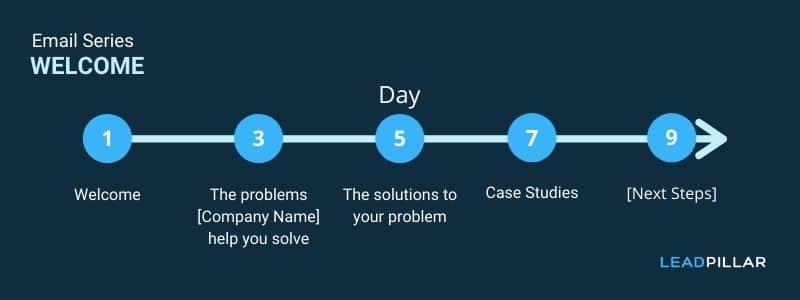
Day 1 – Welcome
Welcome the prospect to your company and let them know which 5 major problems you help solve.
Show them where they can find more resources on “problem identification”, “defining their requirements”, “service/product overview”, and how you can help them define their needs and service / product options quickly to speed up their sourcing project. You are not only helping them make their sourcing project shorter, you also reduce your own sales cycle.
Provide links to popular content on “problem identification”, “considerations for requirements”, “solution options”.
Day 2 – The problems [Company Name] help you solve
Briefly demonstrate that you understand their problem and the struggles they experience of solving them. You may want to demonstrate that different job titles experience the problem differently and how it impacts their work and business.
Guide the prospect from the email to your website by providing content title and links to your website where you have in depth content that “Teach-to-Solve”.
Day 3 – The solutions that helps solve your problem
Provide a quick overview of your services/products and what major problems they solve for the reader. It is important that you help the prospect understand the connection between problem and solution, so that they are not left on their own to decide. Make it easy to understand.
Guide the prospect to the service/product pages where this is described in more detail.
Day 4 – Case Studies
Case studies with testimonials is the way to showcase to the prospects you expertise, and how streamlined your process is of achieving results for your customers. You time to shine.
Provide titles and links to case studies for different services/products.
Day 5 – How we help customers like you
Introduce the prospect of “how it works”, the process you use to help them achieve their results so they know what guidance they can expect from you. You may want to mention the service and support staff that is available to them to ensure they have considered everything for their requirements and how to match it to the right solution.
You could guide them to the solution implemented. how you help your customers solve the problems that you mentioned in your previous email.
Invite to additional content/resource to help (checklist for “considerations when defining your requirements”, “finding the service that solves your problem”.
Day 6 – [Next Steps] We help you speed up your buying process
The prospect may represent multiple decision makers in their organisation and alignment between them is key for the prospect progressing on their buyer’s journey and key for your success. Offer a Q&A video call, or meeting, where they can ask questions and you can talk them through a couple of cases and provide them an opportunity to visualize the process and solution, which they can discuss internally.
2. LEAD NURTURING email series
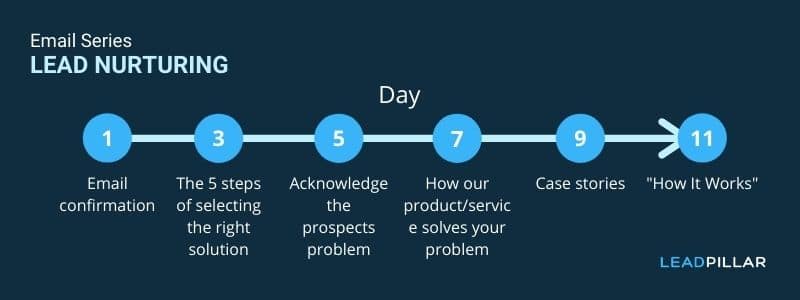
77% of B2B buyers say that their latest purchase was very “complex” or “difficult”
Gartner
Buyers typically state that when they research, they can’t find the information they are looking for, that it is not relevant for their industry and type of problem, and that the information did not prove or illustrate the quantitative benefits.
So to provide a really valuable lead nurturing series, the content quality must be in place. Great content that really adds value to the prospect’s buyers journey, will make this email series really effective for the buyer and prove you as the trustworthy expert.
You have now welcomed your new prospect Now it’s time to help your prospects make their buyers journey easy and speed up their sourcing project towards specifying their fundamental problem, how to solve it, exploring the solution options, and specifying their requirements.
Here are some lead nurture email examples:
Email 1: The 5 steps of selecting the right solution to solve your problem
Show the prospects what a requirement definition could look like and guide them through the considerations they need to make to help create clarity and internal alignment.
Link to relevant resources on “requirements worksheet”, “consideration checklist”, “service/product selector”, and pages where you describe which problems each service/product solves.
Email 2: Acknowledge the prospects problem
Trust is built when you understand the prospects problem because you have solved them many times before in industries like theirs.
Guide the prospect to each of the pages where you “teach-to-solve” their 5 biggest problems, and how to solve them.
Email 3: Provide more content that addresses other typical problems.
Demonstrate that you understand other problems that your prospect experiences to deepen the trust and provide your insight and experience as a source of information and clarity. It helps the prospect feel “certainty” that they can solve their problems without the frustration and complexity they might feel at the time.
Link to content where you “teach-to-solve” additional challenges that typically arise when selecting solutions other than yours, so you demonstrate why your solutions are “complete”.
Email 4: Show how your product/service solves that problem.
For any given service or product that you offer, you can show the prospect of how their process changes with your solution and how this solves their problem.
Link to a video or work process with screenshots where you show them the process of how your service or product solves their problem. It can be “book a demo” or a video that they need to provide contact information to access.
Email 5: Send case stories of how you solve customer problems.
Your time to shine and show off your excellent case stories. Make sure that the “success” description includes the data (percentage or actual data if possible) so that it actually helps the prospect build their business case and get a preference for your service/product. Case stories without data is a nice story without justification. It leaves the prospects with their own guesstimates. You have the experience, so share it.
Link to case stories by industry or service/product, so it’s easy to pick the once most relevant to the prospect.
Email 6: Explain how you help identify and solve their problem.
You have guided the prospect with your experience and created clarity, trust and helped make the process easier, this far. Now it’s all about the prospect and getting their requirements defined and selecting their service/product options.
Show them how you help them through their requirements and solution options, the information they need to find, and their current situation that causes the problem.
This should be a simple step 1, 2, 3 description.
Create the expectation that you will help them with a rough estimate of the investment. Your prospect will be very eager to know what the price level is at this time, so do not avoid the topic
Invite the prospect to schedule a call, call you directly ,or email you.
3. RE-ENGAGEMENT Email Series
Your prospect has been reading and downloading your content but now gone silent.
Maybe there was no formal sourcing process, maybe the budget couldn’t be secured, they found a solution elsewhere, the sourcing project got handed over to procurement, the prospect found a new job or got promoted, a lot of changes can happen that causes the process to stop.
First step is to find out if the contact person still needs to find a solution and still with the company.
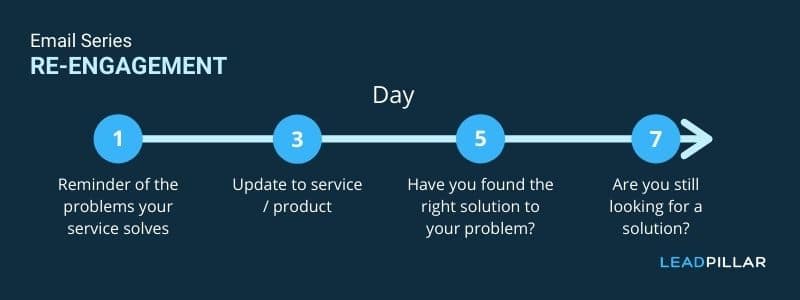
Email 1: Remind prospects of the value of your service/product.
Show the prospect that you have noticed their interest and reaching out to hear if they found it helpful in defining their requirements and solution options, or if they are struggling with understanding how to solve their problem. Offer your help so they can move forward quickly.
Prospects are always looking for a quick process to find the solution.
After that they can hand it over to procurement for a Request For Proposal (FRP), agreement and pricing.
If they haven’t read or downloaded content related to “problem identification”, “requirements definition” or “solution option”, then provide links to these resources.
Email 2: Are you still looking for a solution?
If the reason for “silence” is that something else got in the way, budget was not secured, or it was handed over to someone else, try reminding them on what they are trying to achieve by sharing your case stories.
Ask them if a solution to the problem is still relevant, and offer to help ensure that the solution options they are considering are match their requirements.
Motivate them to share it with their fellow decision makers, in case someone else has taken over the lead on the buyers journey.
Email 3: Do you need a timeline and estimate for your business case?
Timeline and pricing are elements that prospects are looking to get answers on both early and in the final stage of their buyers journey. If you are familiar with the sales methodology “Solution Selling” pricing is considered early to find out what solutions to consider that would give an indication of the budget that needed. The answers are most often “it depends”, so the prospect then starts to focus on describing their problem and solution requirements, and research solution options. They will then again return to “pricing” and “timeline” as final criteria for deciding.
Offer the prospect to help with timeline and pricing estimates for implementing their solution through a video call, where you demonstrate understanding of their problem and take them through solution options so they understand what drives pricing.
You want to be the one that helps them find the best match between pricing and their solution requirements.
Email 4: Have you found the right solution to your problem?
The goal is to qualify which prospects are actively looking for a solution, have a budget, timeline, and defined decision makers. If they are not responding to your emails or calls, it’s time to establish if they are still looking or not. There is no need to pursue silent prospects indefinitely, so lets qualify them, and so we don’t inflate our sales pipeline.
Share with them that you have reached out to them with no response and just wanted to ask if they found an alternative solution, if they did not secure the budget at this time, or decided it was not a priority.
Let them know that you are available to help them when they are ready and will await their future response.
4. PERSONAL OUTREACH email series
Finding the opportunities where you can connect the prospect with the sales rep is not only done through nurturing but also during specific events in the prospects buyers journey.

Email: I can help find all the relevant information you are seeking
You have identified your sales qualified leads (SQL) and as they re-visit your service offering pages and your pricing pages, they trigger an automated email.
In the email you introduce yourself, with the message that you have noticed their interest in your specific service and pricing, and offering them to connect with you to define their specific requirements and help them identify the best solution to solve their problem.
Offer additional resources and a link to schedule a call.
Email: How can I help?
Another contact, from your current prospects company, just downloaded and read specific content on your website. This indicates that your content is being shared in the organisation.
You could send an email to your new contact with an offer to provide them with all the relevant info they need.
You could also offer to schedule a video call with the fellow decision makers to save them time with a quick presentation and provide them with the information and estimates they need to get confidence that they have considered everything they need.
Sharing your presentation with them after the call for internal alignment will help you become the benchmark in their buyers journey.
5. UP-SELL / UPGRADE email series
Adding the specific services and products that your customers are currently buying, to your CRM system, will allow you to target them with offerings that they are currently not buying or buying elsewhere.
If your customers are currently buying a service, where you are also offering a complimentary service, that will allow them to enjoy more of the benefits they are already seeing.
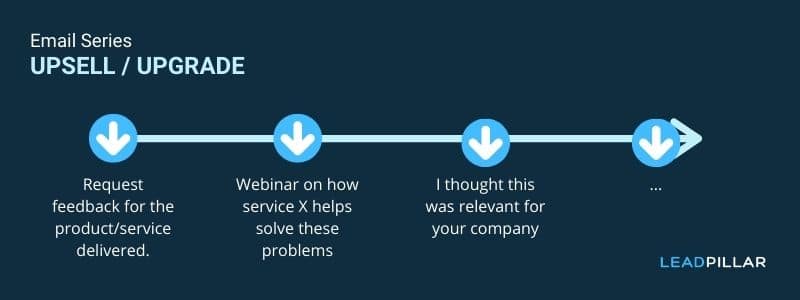
Email 1: Request feedback for the product/service they received.
Too many companies never follow up with their customers to know the success of the service/product the customer received. It’s a shame, and it’s really the best way to understand how to improve your product and service, and carry one solving more problems for your customer.
Email 2: Webinar on how service X helps solve these problems.
Current customers are very likely to follow your content and event offerings to stay abreast on how to get more out of what they already bought or how they can solve more challenges.
Webinars on common problems and how to solve them is an easy and cost effective way of reaching many of your customers in one session, with the chance of spotting opportunities that you can then follow up with afterwards with an automated email.
Email 3: Webinar, please help us get better
A natural follow up to a webinar could be a request for feedback.
In that process you can also ask if they found it relevant to their situation.
Provide a link to your evaluation form and always have a “schedule a call” link and “direct phone number” to have a personal conversation with your customer.
Email 4: I thought this was relevant for your company
Identifying customers who are buying a service where you are offering a complimentary service, is always a great value add to your customers. It helps them stay abreast of opportunities to enhance their business without having to do the research themselves and spend time they don’t have. Take advantage of this and become an expert that understands their business.
Send them your thoughts on what you have considered would be a relevant complementary service to solve on the problem you know they have, whether it’s a new or current service/product you are offering.
6. SALES REP NOTIFICATIONS
The purpose is to connect the sales rep and the prospect. It’s time to connect person to person.
When prospects, who belongs to a ideal customer profile account, increase in engagement on your website, and reads / downloads content in the “solution exploration” and “requirements definition” stages of the buyer’s journey, it’s time to notify your sales rep.
Using the workflow feature in your marketing automation tool, set the trigger level of the specific content that the prospect has read and downloaded, that indicates that a prospect is interested in your service and solution.
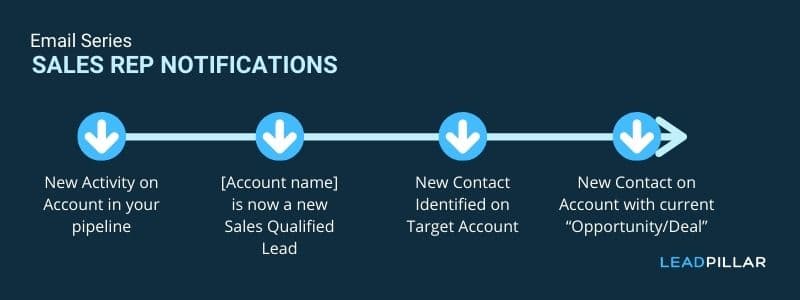
Email: New Contact on Target Account
You may have identified a top 100 – 200 Ideal Customer Profiles (Target Accounts) that you want as customers, but do not currently have any opportunities with.
As you have a campaign on LinkedIn targeting these companies with specific ads, they will start consuming your content.
Let sales know when a new contact is identified with a target account they are pursuing, it’s key for sales when working their way into the organisation.
Email: New Sales Qualified Prospect / Account – High Activity
Marketing has agreed with sales on what an ideal prospect looks like, the information we would like to have before defining them as a sales qualified lead (SQL). So once a prospect triggers these requirements, send a notification to the sales rep. It’s time to reach out.
Show sales what content has been consumed, downloaded, the level of activity.
Email: New Contact with “Opportunity/Deal” Account
When significant activity happens on target accounts that sales are currently working with, help sales with a notification email. A new contact on a target account with an open “opportunity” in the sales pipeline, is such an example. This could indicate a previously unidentified decision maker, or decision influencer. Let sales know what content they have consumed, downloaded, and level of activity, so sales identify what information and guidance they should reach out and offer to the new contact. Speaking to all decision makers is key to ensure alignment and complete understanding of the problem and which is the right solution.


